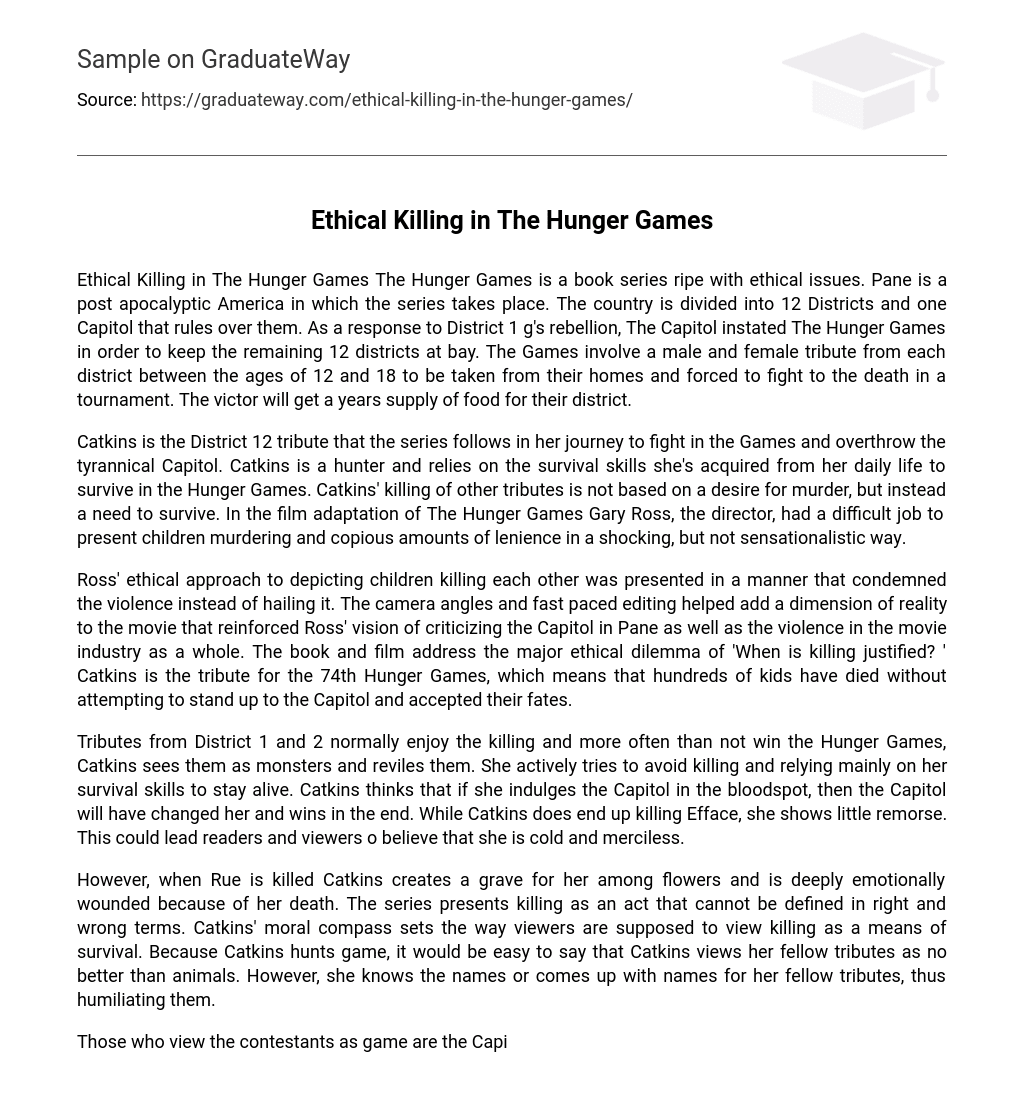The Hunger Games is a book series ripe with ethical issues. Pane is a post apocalyptic America in which the series takes place. The country is divided into 12 Districts and one Capitol that rules over them. As a response to District 1 g’s rebellion, The Capitol instated The Hunger Games in order to keep the remaining 12 districts at bay. The Games involve a male and female tribute from each district between the ages of 12 and 18 to be taken from their homes and forced to fight to the death in a tournament. The victor will get a years supply of food for their district.
Catkins is the District 12 tribute that the series follows in her journey to fight in the Games and overthrow the tyrannical Capitol. Catkins is a hunter and relies on the survival skills she’s acquired from her daily life to survive in the Hunger Games. Catkins’ killing of other tributes is not based on a desire for murder, but instead a need to survive. In the film adaptation of The Hunger Games Gary Ross, the director, had a difficult job to present children murdering and copious amounts of lenience in a shocking, but not sensationalistic way.
Ross’ ethical approach to depicting children killing each other was presented in a manner that condemned the violence instead of hailing it. The camera angles and fast paced editing helped add a dimension of reality to the movie that reinforced Ross’ vision of criticizing the Capitol in Pane as well as the violence in the movie industry as a whole. The book and film address the major ethical dilemma of ‘When is killing justified? ‘ Catkins is the tribute for the 74th Hunger Games, which means that hundreds of kids have died without attempting to stand up to the Capitol and accepted their fates.
Tributes from District 1 and 2 normally enjoy the killing and more often than not win the Hunger Games, Catkins sees them as monsters and reviles them. She actively tries to avoid killing and relying mainly on her survival skills to stay alive. Catkins thinks that if she indulges the Capitol in the bloodspot, then the Capitol will have changed her and wins in the end. While Catkins does end up killing Efface, she shows little remorse. This could lead readers and viewers o believe that she is cold and merciless.
However, when Rue is killed Catkins creates a grave for her among flowers and is deeply emotionally wounded because of her death. The series presents killing as an act that cannot be defined in right and wrong terms. Catkins’ moral compass sets the way viewers are supposed to view killing as a means of survival. Because Catkins hunts game, it would be easy to say that Catkins views her fellow tributes as no better than animals. However, she knows the names or comes up with names for her fellow tributes, thus humiliating them.
Those who view the contestants as game are the Capitol and Kingmakers, as evidenced by the Mutations, implications of dead tributes released to kill the remaining tributes Of the hunger games. Suzanne Collins, the author Of the Hunger Games Trilogy, was inspired by peoples’ fascination with reality TV as part of why she wrote the Hunger Games series. Portraying the violence as realistic and gruesome was a daunting task for Gary Ross. I believe that the violence was not sensationalists in the film and thus stayed true to Collins’ vision of a risky bloodbath.
In most mainstream media when the good guys kill the bad guys we cheer and praise the hero for their bravery. In the Hunger Games, even the richer district tributes are all victims of a horrific circumstance in the end. In the book ACTA begs for Catkins to shoot him while Mutations are slowly eating him alive, prolonging his death. However, an interesting change in the movie is ACTA is dangling PETA over the cornucopia while screaming about his realization that his life and subsequent death are merely entertainment for the Capitol and nothing more.
This additional character development for ACTA helped show that even though he was a career tribute; in the end he was able to realize the horror of the games and their true purpose. The humiliation of ACTA in the film helps reinforce the unnecessary brutality of the games and supports the idea that killing in the Games has gray area for all the tributes and not just Catkins. Killing in The Hunger Games is presented as an ethical issue that has many shades of grey instead of a defined “right” or “wrong” act. Catkins is the moral compass in which we see that killing is done as a means of survival instead of for sport or pleasure.
The contrast to Catkins’ view is the Capitol’s enjoyment of the games. Gary Ross’ approach to the film by depicting the killing in a violent and not sensationalist way helped reinforce the ethics set in place by Catkins and Collins. Humiliating ACTA, who was depicted as the film’s villain, at the end also helped paint the picture that ambiguity of whether killing is ethical applies to all tributes and entrust Catkins.





